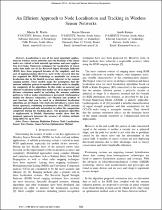 ResearchSpace
ResearchSpace
An efficient approach to node localisation and tracking in wireless sensor networks
JavaScript is disabled for your browser. Some features of this site may not work without it.
- ResearchSpace
- →
- Research Publications/Outputs
- →
- Conference Publications
- →
- View Item
| dc.contributor.author |
Mwila, MK

|
|
| dc.contributor.author |
Djouani, K

|
|
| dc.contributor.author |
Kurien, A

|
|
| dc.date.accessioned | 2015-08-19T11:13:42Z | |
| dc.date.available | 2015-08-19T11:13:42Z | |
| dc.date.issued | 2014-12 | |
| dc.identifier.citation | Mwila, MK, Djouani, K and Kurien, A. 2014. An efficient approach to node localisation and tracking in wireless sensor networks, IEEE Globecom 2014- Ad Hoc and Sensor Networking Symposium, Austin - Texas (USA), 8-12 December 2014, pp 492-497 | en_US |
| dc.identifier.uri | http://hdl.handle.net/10204/8097 | |
| dc.description | IEEE Globecom 2014 - Ad Hoc and Sensor Networking Symposium, Austin - Texas (USA), 8-12 December 2014 | en_US |
| dc.description.abstract | Localisation is one of the most important applications for wireless sensor networks since the locations of the sensor nodes are critical to both network operations and most application level tasks. Numerous techniques for localisation of sensor nodes that make use of the Received Signal Strength Indicator (RSSI) have been proposed because of the simplicity and low cost of implementation. However, most of the research thus far has regarded the RSSI technology as unsuitable for accurate localisation due to the limited accuracy inherent to the current ranging models. These models make the assumption that the antenna radiation pattern is omnidirectional in order to simplify the complexity of the algorithms. In this study, an accurate and efficient localisation method that makes use of an improved RSSI distance estimation model by including the antenna radiation pattern as well as nodes orientations is presented. Mathematical models for distance estimation, cost function and gradient of cost function, that can be used in a distributed localisation algorithm, are developed. This study also introduces a sensor data fusion approach, combining accelerometer data, RSSI, antenna radiation pattern and node orientation to reduce the computation complexity during the tracking phase. The proposed algorithm is implemented in Matlab. Simulation results show that the proposed approach increases the accuracy of existing methods using RSSI by up to 59%. | en_US |
| dc.language.iso | en | en_US |
| dc.publisher | IEEE Globecom 2014 | en_US |
| dc.relation.ispartofseries | Workflow;14265 | |
| dc.subject | Antenna radiation pattern | en_US |
| dc.subject | Node localisation | en_US |
| dc.subject | Sensor data fusion | en_US |
| dc.subject | Gauss-Newton optimisation method | en_US |
| dc.subject | Wireless sensor networks | en_US |
| dc.title | An efficient approach to node localisation and tracking in wireless sensor networks | en_US |
| dc.type | Conference Presentation | en_US |
| dc.identifier.apacitation | Mwila, M., Djouani, K., & Kurien, A. (2014). An efficient approach to node localisation and tracking in wireless sensor networks. IEEE Globecom 2014. http://hdl.handle.net/10204/8097 | en_ZA |
| dc.identifier.chicagocitation | Mwila, MK, K Djouani, and A Kurien. "An efficient approach to node localisation and tracking in wireless sensor networks." (2014): http://hdl.handle.net/10204/8097 | en_ZA |
| dc.identifier.vancouvercitation | Mwila M, Djouani K, Kurien A, An efficient approach to node localisation and tracking in wireless sensor networks; IEEE Globecom 2014; 2014. http://hdl.handle.net/10204/8097 . | en_ZA |
| dc.identifier.ris | TY - Conference Presentation AU - Mwila, MK AU - Djouani, K AU - Kurien, A AB - Localisation is one of the most important applications for wireless sensor networks since the locations of the sensor nodes are critical to both network operations and most application level tasks. Numerous techniques for localisation of sensor nodes that make use of the Received Signal Strength Indicator (RSSI) have been proposed because of the simplicity and low cost of implementation. However, most of the research thus far has regarded the RSSI technology as unsuitable for accurate localisation due to the limited accuracy inherent to the current ranging models. These models make the assumption that the antenna radiation pattern is omnidirectional in order to simplify the complexity of the algorithms. In this study, an accurate and efficient localisation method that makes use of an improved RSSI distance estimation model by including the antenna radiation pattern as well as nodes orientations is presented. Mathematical models for distance estimation, cost function and gradient of cost function, that can be used in a distributed localisation algorithm, are developed. This study also introduces a sensor data fusion approach, combining accelerometer data, RSSI, antenna radiation pattern and node orientation to reduce the computation complexity during the tracking phase. The proposed algorithm is implemented in Matlab. Simulation results show that the proposed approach increases the accuracy of existing methods using RSSI by up to 59%. DA - 2014-12 DB - ResearchSpace DP - CSIR KW - Antenna radiation pattern KW - Node localisation KW - Sensor data fusion KW - Gauss-Newton optimisation method KW - Wireless sensor networks LK - https://researchspace.csir.co.za PY - 2014 T1 - An efficient approach to node localisation and tracking in wireless sensor networks TI - An efficient approach to node localisation and tracking in wireless sensor networks UR - http://hdl.handle.net/10204/8097 ER - | en_ZA |





